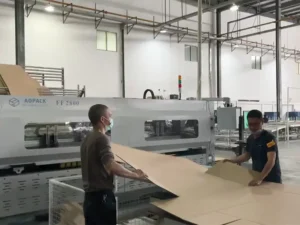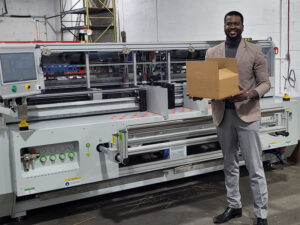Creating the perfect e-commerce box for your customers can help build a lasting connection with shoppers, boosting both profits and customer retention. Whether your goal is to delight customers as they unbox their purchase or to incorporate sustainable materials into your packaging, our guide to e-commerce boxes is here to assist you. By understanding the steps to design an aesthetically pleasing e-commerce box, you can enhance your services, increase sales, and improve your return on investment (ROI).
1. What is E-Commerce Packaging?
E-commerce packaging refers to the boxes and materials used by online retailers to ship products directly to customers who make purchases online. These packages arrive at the customer’s doorstep with minimal third-party interactions, aside from the mail service. Today’s consumers value the convenience of shopping online without leaving their homes, making it a popular option across all age groups.
Given the popularity of e-commerce, creating an enjoyable and memorable unboxing experience is crucial. Reliable shipping boxes and services help build trust with customers. Additionally, shipping boxes offer a fantastic opportunity to highlight your brand’s creativity and unique identity, helping you stand out from competitors. With the right packaging, you can demonstrate to customers why they should continue choosing your brand over others.
E-commerce boxes can be fully customized with colors, logos, and packaging slips to align with your brand image. It’s also important to consider factors like protection and durability to ensure the product remains safe during transit, handling, and shipping. By designing packaging that is both functional and special, you can leave a positive impression on customers and support your business’s long-term success.
2. Importance of Creating the Perfect E-Commerce Box
Designing the ideal e-commerce box is vital for leaving a lasting impression on customers. You want shoppers to perceive your brand as trustworthy, encouraging them to make repeat purchases. By using reliable packaging materials and creating an aesthetically pleasing box, you can make your brand more appealing than the competition. For example, I have a client who is a graphic overlay manufacturer. In order to highlight the advantages of his products, he uses customized packaging to expose his brand.
1) Protection
Ensuring your product is protected from damage during transit is one of the most crucial aspects of e-commerce shipping. The right packaging materials and fillers are essential for providing a cushioned product that won’t crack or break.
Secure packaging materials not only protect the product but also satisfy customers. When items arrive undamaged, it reinforces your business’s reliability. Ready-to-use products add value to your brand, resulting in fewer returns or refunds due to faulty or broken items. Making a great first impression is key to building a lasting brand and retaining customers.
2) Marketing
Creating a marketable product can significantly boost your company’s return on investment. Custom e-commerce boxes offer an excellent way to provide a fun and memorable experience while promoting your brand. A standout design will enhance your brand’s equity and help your company stand out.
With a unique custom design, you can differentiate your product from competitors. Attractive colors, custom logos, and memorable images and inserts can build anticipation for orders and foster a connection with your brand.
3) Customer Experience
The customer experience is a crucial component of building custom boxes. As an online business, you’ll have fewer direct interactions with customers, making it essential to consider how they will feel when receiving and opening the package.
Without the opportunity for in-person or hands-on promotions, custom packaging can help distinguish your business from competitors. The box becomes an extension of your brand, ensuring customer satisfaction with their purchase. Custom e-commerce boxes can enhance retention and loyalty while supporting consistent company growth.
3. How to Create the Perfect E-Commerce Box — A Step-by-Step Guide
Creating the perfect e-commerce box involves careful consideration of various elements, from packaging types to design details. Here’s a step-by-step guide to help you develop successful e-commerce packaging that aligns with your brand and meets your customers’ needs.
1) Packaging Type
Select the appropriate packaging type based on the product you intend to ship. Whether you’re dealing with delicate, fragile items or heavy, bulky goods, a well-constructed package will protect your product while promoting your brand. Options include poly mailers, bubble mailers, and corrugated boxes.
- Poly mailers: These self-sealing polyethylene envelopes are ideal for shipping lighter, flexible items. They are waterproof and lightweight, allowing for efficient shipping of large quantities. Custom sizes are available, though printing logos or lettering can be challenging. Consider eco-friendly options for recyclability.
- Bubble mailers: These envelopes, lined with bubble wrap, offer additional protection for delicate or lightweight items like jewelry, books, or small electronics. While they provide various print options, paper versions may be less weather-resistant than plastic ones, which are not typically curbside recyclable.
- Corrugated boxes: Offering a wide range of styles and customization options, corrugated boxes provide excellent protection and are suitable for nearly any product. They often contain post-consumer waste, making them a sustainable choice, and allow for extensive custom printing and color options.
2) Box Styles
Choose a box style that suits the product you’re shipping. Different styles include:
- Traditional: Features four flaps on the top and bottom that meet in the center.
- FOL flaps: Full-overlap flaps for heavy products, offering stacking strength and damage resistance.
- Snap-lock closure: Uses secure bottom flaps for added security.
- Auto-bottom closure: Utilizes interlocking bottom flaps for easy assembly.
- Roll-end front tuck: Provides excellent protection, popular with subscription services, and available with dust flaps.
- Self-sealing: Includes a tape strip for convenient packing, sealing, and shipping.
3) Material Thickness
Consider the material thickness of your e-commerce box, especially if shipping delicate or bulky items. Use E-flute thickness for products from the retail, food, or beauty industries, and B-flute thickness for items like furniture, shoes, or industrial products.
By thoughtfully selecting each aspect of your e-commerce packaging, you can create a memorable unboxing experience that enhances your brand’s reputation and encourages customer loyalty.
4) Printing Methods
When designing a custom e-commerce box, your company can choose between two printing methods: digital and offset.
- Digital printing: This method transfers documents to a substrate and then to a device that accepts graphics and text outputs. The image or text is directly inked onto your packaging material. Digital printing is ideal if you frequently ship orders in low quantities and seek a cost-effective option. It allows you to save time and money while maintaining a simple yet eye-catching design. This method is best suited for low-quantity shipments.
- Offset printing: This technique uses a printing press to transfer ink from a plate to a roller and then to paper. It’s commonly used in newspapers, stationery, custom boxes, and brochures. Although more expensive, offset printing offers superior quality. If you plan to include custom inserts or inner box printing, offset printing is the way to go.
5) Void-Fill Materials
Void-fill materials are used to fill the space inside the custom e-commerce box, preventing the product from shifting during transit and safeguarding it from damage. Consider incorporating the following materials:
- Air pillows: Prefilled air pillows provide quick and effective cushioning and protection. However, recipients must pop and dispose of them after use, and they are not curbside recyclable.
- Packing peanuts: While traditional packing peanuts are not eco-friendly, biodegradable options offer a great alternative, allowing customers to easily dispose of or dissolve them in water.
- Bubble wrap: Available in sheets or rolls, bubble wrap comes in various thicknesses and sizes for added protection.
- Packing paper: Packing or crinkle paper is available in different colors and patterns, ensuring product safety while enhancing your brand image.
6) Promotional Material
Including promotional materials inside your package can strengthen the relationship between your brand and customers while providing valuable information. Consider adding items like a printed newsletter, custom note, or step-by-step instructions for product use.
Custom notes can resemble postcards, featuring the customer’s name or a short handwritten message expressing gratitude for their purchase. Educational materials might include directions or unique recommendations.
7) Packing Tape
Enhance the customer experience and the appearance of your packaging by using creatively designed, patterned, and styled packing tape. When selecting packing tape, consider factors such as the package’s surface, the product’s weight, and the seal at the box’s bottom. Decide whether to apply the custom tape by hand or with a machine. Also, consider the package’s potential exposure to weather or temperature and sustainability. The right packing tape, aligned with your brand’s images, patterns, and colors, can catch customers’ eyes and improve business retention.
8) Box Seals
Box seals, which are stickers or precut labels, are used to secure the edges of your package. They provide time-saving benefits and add a professional touch to your design. To maximize your investment, avoid over-purchasing and buy seals in bulk. Consider circular, rectangular, or square shapes made from materials like kraft, white paper, or acetate.
9) Packing Slips
Packing slips serve as an effective marketing tool when strategically placed. Position the receipt and packing slip near the bottom of the box, allowing customers to first enjoy the product before accessing additional information. Customize your packing slips to match the box’s design, incorporating your logo or product images alongside purchasing details. Consider adding a QR code with product usage instructions or a coupon code. Packing slips can encourage repeat purchases and keep customers engaged with your brand.
10) Inserts
Custom e-commerce box inserts protect your product from damage and help organize the package’s contents. Many businesses use cardboard or foam inserts to prevent delicate items from moving around. Custom inserts enhance the box’s interior appearance and strengthen brand identity. Whether you choose plastic, paperboard, or foam inserts, they can be customized in color and printed with information to assist customers or promote your brand image as soon as the package is opened.
11) Samples and Gifts
Including extra samples or gifts can delight customers and enhance their experience. Consider adding items like stickers, coupons, small product samples, or a keychain. Samples of other products can pleasantly surprise customers and effectively promote your business.
Cross-selling through samples introduces new products you wish to highlight. Offering a small gift or sample can entice customers and encourage them to return for more.
12) Artwork Design
Developing the artwork is a crucial final step in finalizing your e-commerce box. Start by considering your planned color scheme. Reflect on your brand’s standard colors and themes, whether you prefer pastels, neons, or metallics. Ensure your packaging aligns with your brand’s motif, creating a cohesive narrative and serving as effective advertising.
If you’re crafting a new brand color scheme, consider the psychology of color. For example, red is often used in food products to evoke hunger, while blue or green can suggest cleanliness or natural products, depending on your offerings.
Finally, decide on the placement of your brand logo. It should be prominently visible when the customer receives the package. Consider printing it on both the interior and exterior of the box. Design a logo that complements your color palette and brand image, ensuring it stands out and is memorable. An eye-catching logo helps boost customer retention and brand recognition.
4. Conclusion
E-commerce packaging is a crucial element in the growth and success of an online business. It not only safeguards products during storage and shipping but also enhances customer satisfaction and bolsters brand recognition. Customizing your product packaging is an effective strategy to establish a strong brand identity and boost your chances of success in the competitive e-commerce landscape.
If packaging has been an overlooked aspect of your business, now is the perfect time to focus on it and leverage its full potential. By investing in thoughtful and strategic packaging, you can create a memorable unboxing experience that resonates with customers and sets your brand apart.
How useful was this post?
Click on a star to rate it!
Average rating 0 / 5. Vote count: 0
No votes so far! Be the first to rate this post.









